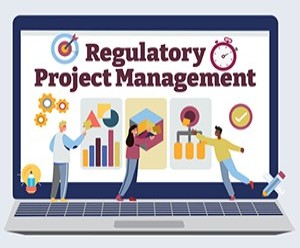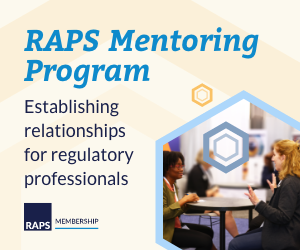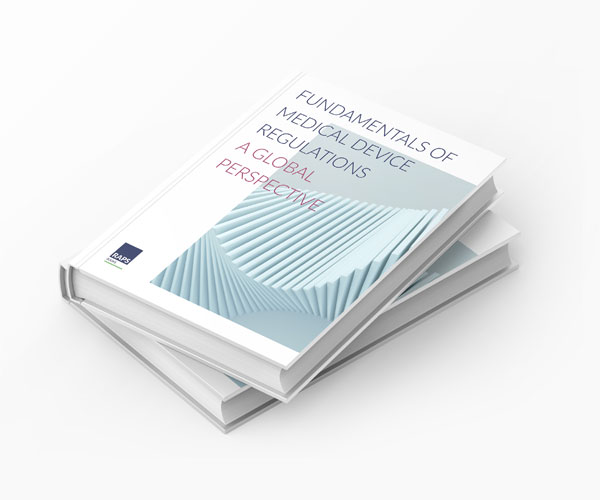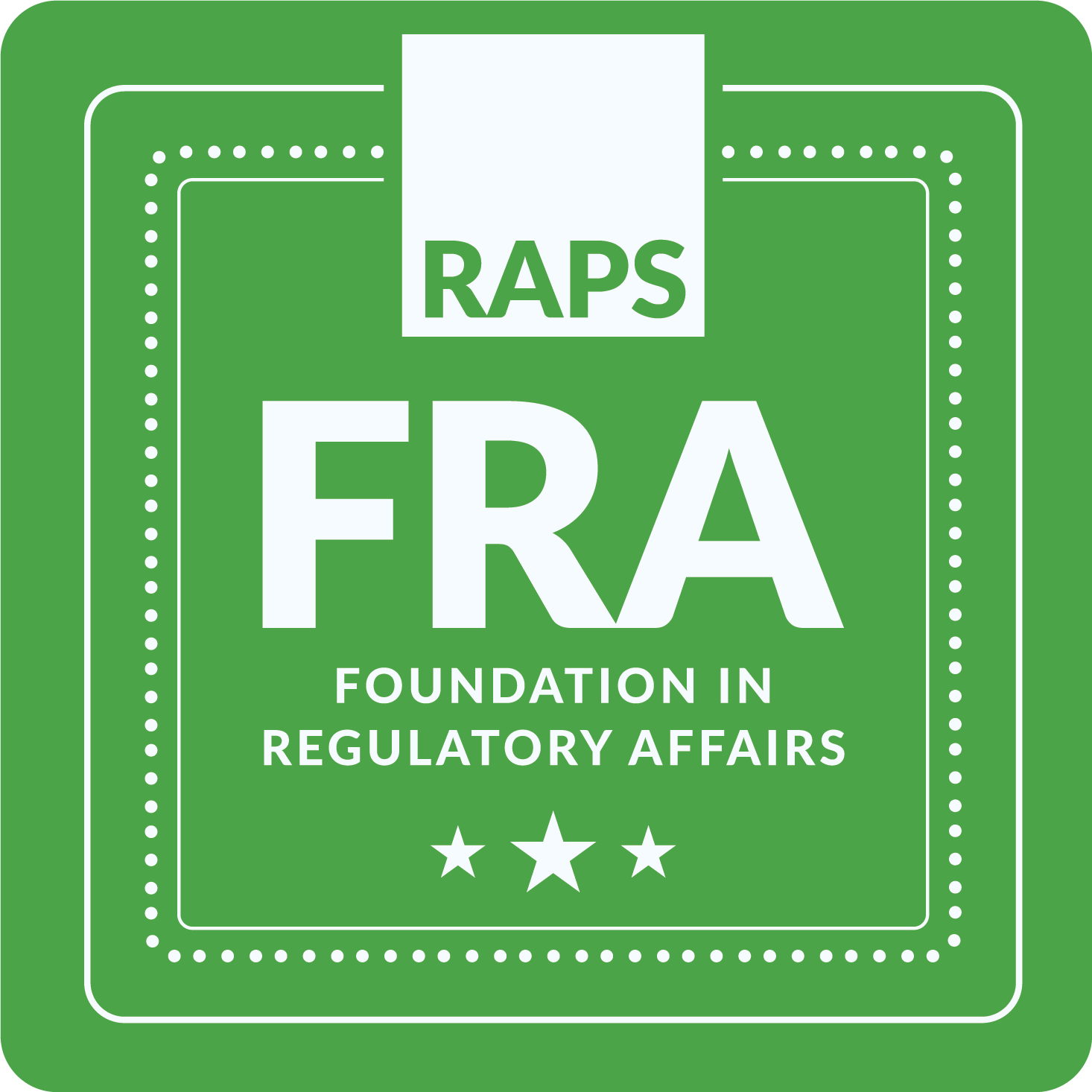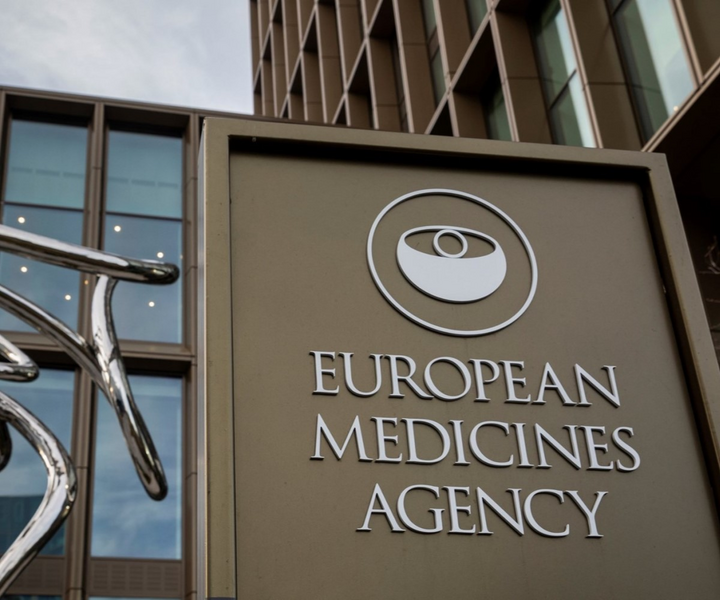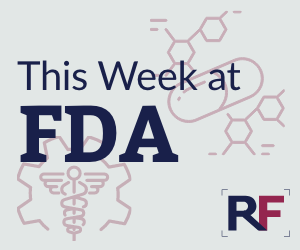The ASEAN harmonization of technical standards on health supplements – An industry perspective
![]() Feature Articles | 28 June 2021 | Citation |
Feature Articles | 28 June 2021 | Citation | ![]() PDF
PDF
Many countries in the Association of Southeast Asian Nations (ASEAN) require registration of health supplements, which generally takes a few months to years. There have been many different interpretations of the principle-based standards or regulations among the ASEAN member nations, making right-first-time regulatory submissions for the region hard to achieve and, absent defined review limits (such as rounds of questions/letters of deficiencies), lead times for approvals can be long and variable. Although it is recognized there is much to be done, harmonization of the proposed 10 sets of technical standards is expected to be a major first step forward in enabling regulatory submissions and reviews of health supplements in the ASEAN region.
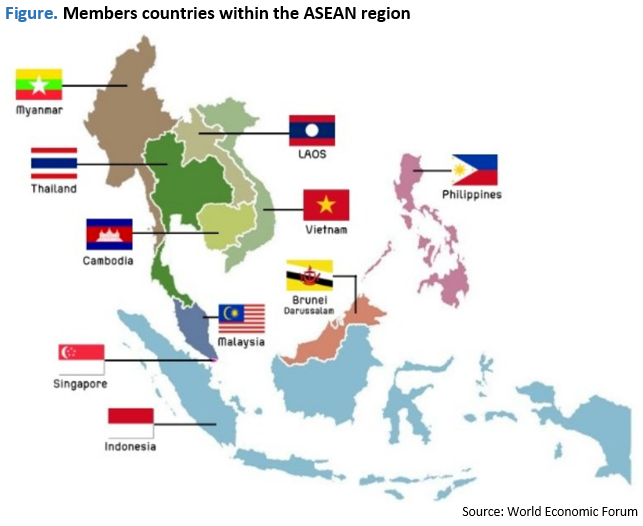
ASEAN vs EU governance: Similarities and differences
Some scholars have argued that ASEAN’s institutionalization is an imitation of the European Union (EU) form without the substance.1-3 However, Wong is of the opinion that the EU’s influence is not an active presence and serves only as a passive reference point – for example, in the establishment of the ASEAN Charter in 2007.4 From the perspective of an industry regulatory professional in the region for the past 2 decades, the author is inclined to align with the view of Khong and Nesadurai5 that the ASEAN institutional construct is heavily influenced by the interplay between shared external threats and domestic politics.
The EU has 27 member states and ASEAN has 10. Broadly speaking, the similarities between the ASEAN and the EU can be summarized as below:6
Comparing the similarities, the differences between the EU and ASEAN is much more pronounced. Both institutions were established with different governance models and therefore it is in principle not appropriate to conclude if one is more successful than the other. However, for the sake of understanding the impact of the differences on the regulatory framework, Table 1 provides an overview.6,7
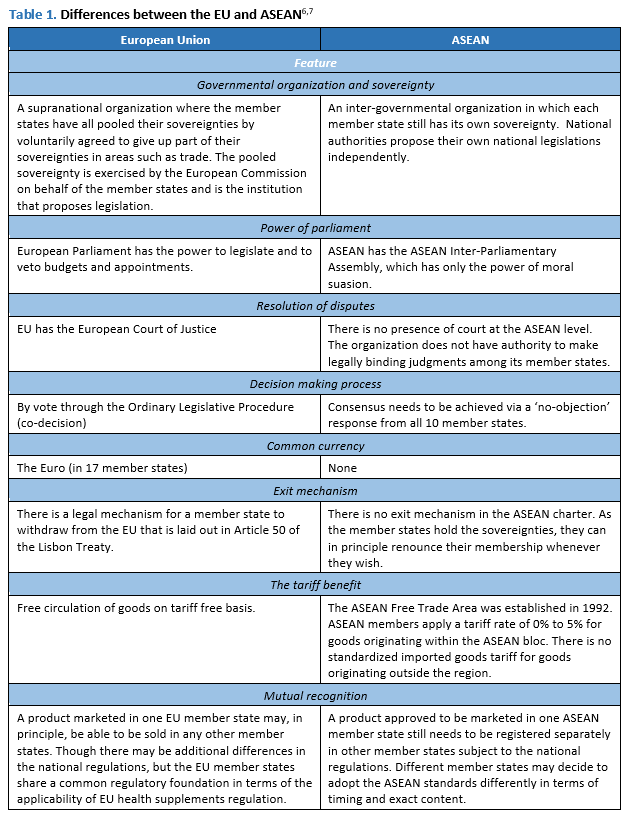
The primary objective of the AEC is to implement the initiatives to achieve a single market and production base, allowing the free flow of goods, services, investments, and skilled labour, and the freer movement of capital across the region. The harmonization was undertaken to enable the removal of technical barriers to trade, especially when such barriers arise because of differences in standards referenced in technical regulations and used for mandatory conformity assessment procedures. In 2004, 11 priority sectors were announced for economic integration based on their comparative advantages in natural resource endowments, labour skills, cost competitiveness, and value-added contribution to the ASEAN economy.9 Among the products prioritized under healthcare and agro-based products were those categorized as pharmaceutical, medical device, traditional medicine and health supplement, cosmetic, and processed food products.10
The ASEAN Traditional Medicines and Health Supplements Products Working Group
The ASEAN Traditional Medicines and Health Supplements Product Working Group (TMHS PWG) was established under the umbrella of the AEC in 2004. The working group reports to the ASEAN Consultative Committee on Standards and Quality (ACCSQ) and, with technical support from the ASEAN TMHS Scientific Committee (ATSC), the joint ACCSQ‒TMHS PWG is tasked with:
The ATSC was formed in 2007 to lead development of the technical standards and requirement. Development was completed in 2015 of 10 harmonized technical standards to be laid out as 10 annexes to the ASEAN Agreement on Regulatory Framework for Health Supplements (the Agreement). The standards sought to harmonize the technical requirements for traditional medicines and health supplement (TMHS) products in the ASEAN member states. In 2020, the details of the Agreement were finalized among the 10 member states.12
Current next steps and target timeline of the ASEAN harmonization of technical standards for health supplements are shown in Table 2.
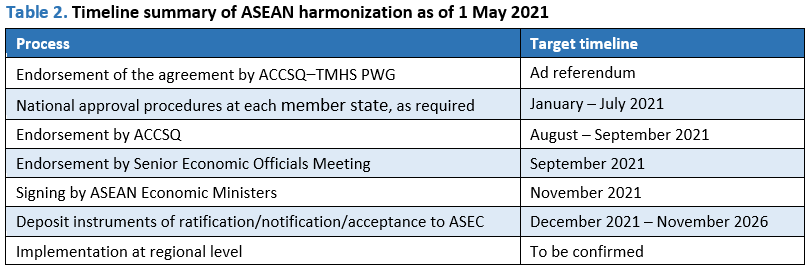
The common technical standards in the Agreement
Good manufacturing practice (GMP) is an essential component in the manufacture of health supplements. The primary objective of GMP is to ensure the quality requirements of all products are met and consistently maintained to safeguard public health. There are 10 chapters in the ASEAN Guidelines on GMP for health supplements.11,12
Besides GMP, the core of the harmonization of technical requirement are in the 10 technical annexes to the ASEAN Agreement that will form the basis of the point of reference for the ASEAN member states to adopt into their national regulations. The 10 annexes are:

Leadership
The TMHS PWG chair from the Health Sciences Authority of Singapore has been dedicated to resolving numerous technical and legal disputes arising from differences in opinions among the member state representatives in product working group meetings. She has been a strong advocate for the member state regulators to focus on the goal to improve the technical standards to increase the competitiveness of the ASEAN TMHS products both in the ASEAN region and the global marketplace. The working group has a consensus-based decision-making mechanism so can be challenging when members do not hold similar positions on specific issues. The chair has been able to navigate and reconcile those differences among the representatives and guide the group through finalizing the Agreement.
Strong public‒private partnership
Another key factor of success is the relatively open and inclusive approach of the TMHS PWG in partnering with the private sector, allowing two industry representatives to provide direct technical inputs to TMHS PWG discussions. These two seats at the table are from the industry sectors of traditional medicine and health supplements, namely the ASEAN Alliance of Traditional Medicines Industries and the ASEAN Alliance of Health Supplements Industry (AAHSA) respectively. As a matter of comparison, the ACCSQ Processed Food Products Working Group (PFPWG) adopts a less open approach whereby it is open to dialogues with the industry on separate forums but not actually offering a seat at the table at the actual working group meetings with the national regulators from all 10 ASEAN member states.
AAHSA represents the health supplements industry in the ASEAN member countries. It is made up of seven, national level health supplement industry associations:
To support the implementation of the harmonized technical standards of health supplements, the industry associations have also provided technical and financial support in capacity building and training programs on implementation of the harmonized technical standards. For instance, AAHSA has contributed scientific experts to support the training for ASEAN Guidelines for Traditional Medicines and Health Supplements Claims and Claims Substantiation hosted by the Philippine Food and Drug Administration in Manila in 2019.
The ASEAN Agreement, which is scheduled to be signed by end 2021, is not technically regulatory harmonization when compared with that of the EU. Although there are harmonized goals at the highest level of political leaders, these goals do not automatically translate into cooperation among national health ministries.13
The following are some of the key challenges the ACCSQ‒TMHS PWG has faced during its 17-year lifespan and some of the challenges they will face:
Member states have absolute sovereignty in national regulations. The Agreement consists of a set of common technical standards, but the regulatory regime of each member state still has absolute sovereignty in implementing their national regulations, which can overwrite these commonly agreed upon technical standards. There will be no single product registration that can be mutually accepted and recognized by other ASEAN member states. In countries where premarket approval authorization is required, companies that market health supplement products in the ASEAN region are still required to file product registrations to the various national health authorities concerned in accordance to the national regulatory requirement.
Significant economic diversity, with different regulatory capabilities among member states. One of the key hurdles in reaching consensus on the speed and depth of economic integration in ASEAN is the range of economic diversity with the organization. In terms of economic diversity in competitiveness, according to the World Bank’s Ease of Doing Business index, Singapore is ranked second globally,14 whereas the CLMV countries (Cambodia, Laos PDR, Myanmar, and Vietnam) rank poorly. Indonesia is ASEAN's largest economy, followed by Thailand and Malaysia, compared with Brunei, Cambodia, Laos, and Myanmar, which are small economies. In terms of GDP per capita incomes, Singapore and Brunei are better than many countries in the Organisation for Economic Cooperation and Development (OECD), whereas Cambodia, Laos, and Myanmar are among the least developed economies.15
The OECD has argued that regulations are integral to economies and societies being functional because they protect citizens, support markets, and ensure delivery of goods and services.16 That suggests there is likely a positive correlation between a country’s regulatory capability and economic development. Under the current regulatory framework for health supplement products in the ASEAN member countries, Singapore and Malaysia are recognized as having well developed regulations in TMHS whereas regulations in Thailand and Indonesia tend to be more restrictive and Cambodia and Myanmar do not have specific regulations on health supplements. On the one hand, Malaysia, Singapore, and Indonesia have implemented the Agreement, either fully or by phasing in common technical standards as they are agreed upon, ahead of the signing. On the other hand, some countries have not initiated any implementations.
National interest to support local small- and medium-sized enterprises. One of the key drivers of the protracted finalization period for the ASEAN Agreement is concern among some member states that their local small- and medium-sized enterprises will lack the capabilities and capacities to implement the technical standards and therefore will be compromised when it comes to competing multinational corporations operating in the region.
One notable example is the concern on the GMP standard for which, until about 5 years ago, some of the bigger member states were still actively pushing for development of a GMP standard that was a compromise between the pharmaceutical and food standards. Around 2 to 3 years later, there was a change in the government representative from one of the member states who subsequently reported that the results of a local level industry survey conducted indicated that their local SMEs did not have the capability to implement the previously agreed upon ASEAN GMP standard for TMHS. Consequently, the ATSC discussion on GMP standards was reopened and delayed for another 2 to 3 years.
Even though there may be political will at the Senior Economic Officials Meeting platform to achieve the harmonization goal, concrete technical issues often surface at the health authorities’ level and the authorities sometime table requests to reopen discussions on areas already agreed upon in previous meetings. Due to the consensus-based decision-making mechanism, any reopening of discussions would delay TMHS PWG progress because it must have all 10 member states agree before any decision can be made. In the example of the GMP standard, the TMHS PWG had to postpone its decision on the GMP standards and seek advice from the ASEAN secretariat on whether a 9-1 vote on the standard would be acceptable. The GMP discussion was subsequently reopened, and it took another 2 to 3 years for all member states to agree to the standard.
Partial implementation – ‘cherry picking’ – and foreseen delays in national implementation. Even though the ASEAN Agreement will be legally binding and require full adoption by the member states, national authorities reserve the right to defer implementation if they feel they are not ready. One way of meeting certain adoption obligations is to implement selected sections of the approved standards preferred by the national regulatory agencies.
“Cherry picking” implementation by the respective national regulatory agencies can then occur due to varying readiness and capabilities of the member states to adopt these harmonized standards. As such, despite having finalized technical standards within the ASEAN Agreement, the result is variations of this agreement being implemented across member states.
In addition, some member states are not ready to implement the Agreement or face technical capability gaps or financial burdens related to national training programs for local regulators and industries. That could also result in delays in implementation in some countries, restricting consumer access to innovations in the TMHS area and preventing multinational companies from enjoying the benefits that come with harmonized regulations, such as harmonized product formulation or labelling and improved economies of scale from streamlining operational processes and cutting costs. Due to this proliferation of national regulations, products imported from other parts of the world into ASEAN will need to comply to the various national regulations enforced by each of the ASEAN member states.
In addition, there is a lack of mutual recognition on TMHS products among the ASEAN member states. Mutual recognition has not been appropriately addressed for TMHS products as of now.
Differences among member states in using food versus drug principles in regulating health supplements. In the ASEAN countries, health supplement products are governed by the food authorities or drug authorities. There is generally a fundamental difference in terms of regulatory principles and primary international references used by regulators from the food authorities compared with the drug authorities. Codex Alimentarius is widely used as the international benchmark for regulators from the food authorities, whereas World Health Organization or International Council for Harmonisation (ICH) standards are being used as primary references in assessing risks when developing technical standards for drug control authorities. Table 4 summarizes the regulatory classifications health supplement products fall under in the different ASEAN member states and the regulating authorities that govern the concerned products.
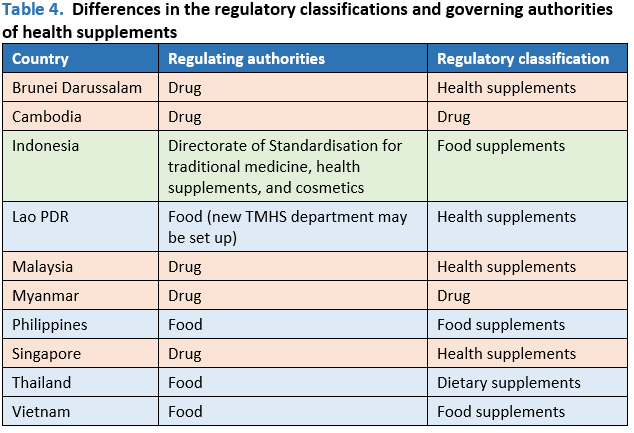
Due to differences in the food and drug control principles and approaches of the different regulators in the TMHS PWG, it was more difficult to reach consensus on the details in the technical standard development process. In some cases, these principles and approaches are also dependent on the background and experience of the regulators representing their countries at the TMHS PWG. In terms of the development of the ASEAN guidelines for TMHS claims and claims substantiation, Thailand and Indonesia leaned more to a pharmaceutical approach. For example, in the health claim technical workstream, the technical experts representing Indonesia were from the department of pharmacology of the local health authority.
In determining the health claim substantiation standard, the experts from Thailand preferred to model after the EU health claim substantiation principles of the European Food Safety Authority, which has often been viewed as inspired by pharmaceutical oriented approach. This European model establishes its evaluation based on either sufficient or insufficient evidence, which created an absolute standard, possibly disqualifying some products from being able to make even general claims based on certain level of scientific evidence. As health supplements are not intended for therapeutic purposes, its substantiation model is more fluid and less standardised unlike pharmaceutical products. In contrast, the US, Australia, and New Zealand have a tiered approach to this matter which ranked the strength of desired claims and the respective level of scientific evidence required for substantiation of said claims. The TMHS PWG took 8 years (from 2008 to 2017) to reach an agreement to adopt this tiered model of health claims substantiation in health supplements.
Operational complexities in health supplements product registrations in ASEAN. Food supplements in the EU and dietary supplements in the US require only notification, and not actual premarket approval, before being place on the market. In contrast, many ASEAN member states require product registration, which extends the lead time by a few months to 2 years before the product reaches the market. In general, the industry encounters difficulties due to many different interpretations of the technical standards or regulations. As many technical standards are more principle based not intended to cover every possible scenario, companies very often need to consult regulatory officers for clarification of technical requirement. It is a common challenge to find that the officers providing advice and the ones receiving and evaluating the application sometimes have different sets of interpretation. As a result, first time right regulatory submissions are hard to achieve especially in some Indo-China countries. In addition, there are no established limits in terms of maximum number of rounds of queries or letters of deficiencies issued by the authorities to applicants of product registrations. Multiple rounds of queries response would require much longer lead time for approvals to be granted.
Technical gaps of the ASEAN technical standards. With the establishment of the 10 sets of technical standards in the Agreement, the health supplement industry will continue to face some short- to mid-term technical challenges, especially in countries with established national regulations or those that are not covered by the approved ASEAN standards. Some examples of such challenges include:
Due to the limitations of vitamin and mineral levels and the types of active ingredients and claims that are not permitted under health supplements classification, companies will need to weigh the pros and cons to decide to register vitamins, minerals, and supplements (VMS) products as generic OTC drugs (under pharmaceutical products regulations) rather than health supplements, in such case there will be additional technical challenges to overcome under drug registration such as:
Harmonization of the technical requirements and guidelines for health supplements in ASEAN will bring about many benefits for member states and their citizens. The process will result in better regulations and better regulatory practices, leading to higher levels of product safety and quality standards for ASEAN consumers. A more robust regulatory framework will raise the levels of trust for regulatory bodies and industry, which would be a fundamental catalyst for more business investment in the ASEAN region. Good regulatory practices are important to ensure appropriate benefit-risk assessment of innovations and development of new technologies. To fully benefit from the TMHS PWG’s efforts to date, health authorities, technical experts, and the health supplements industry need to continue collaborating in the following areas:
This year marks a milestone in the 17-year journey for the ASEAN Agreement, which will be signed into effect at the end of 2021. It is a critical step toward harmonization, but only the beginning of the next phase – national implementations – which will mark the true culmination of the TMHS PWG’s efforts. The health supplements industry and ASEAN member state regulators should continue the culture of public-private partnership in fostering the success of the Agreement by realizing the true benefits of regulatory harmonization through removing technical trade barriers and protecting public health and safety while increasing competitiveness of the ASEAN health supplements industry in the global marketplace.
Abbreviations
AAHSA, ASEAN Alliance of Health Supplements Associations; AATMI, ASEAN Alliance of Traditional Medicine Industry; AEC, ASEAN Economic Community; ASEAN, Association of Southeast Asian Nations; ATSC, ASEAN Technical and Scientific Committee of the ASEAN Traditional Medicine and Health Supplements Product Working Group; CLMV, Cambodia, Laos PDR, Myanmar, and Vietnam; EU, European Union; RDA, recommended dietary allowance; TMHS, traditional medicines and health supplements; TMHS PWG, ASEAN Traditional Medicines and Health Supplements Product Working Group; VMS, vitamins, minerals, and supplements.
About the author
Alicia Ng, MJ, is vice president and head of regulatory affairs and R&D head for the Asia Pacific region for GSK Consumer Healthcare, based in Singapore. She has more than 25 years’ experience working in a range of research and development functions, including product design and development and regulatory and scientific affairs. She previously held regulatory positions at Pfizer and Nestlé. Ng is a nutritionist and has a master of jurisprudence degree from Michigan State University. She can be contacted at aijooalicia.ng@gmail.com
Acknowledgments
The author thanks the following experts for providing either supporting information or professional opinions: Wai Mun Poon, MSc, secretariat of the ASEAN TMHS Scientific Committee of the ASEAN Traditional Medicine and Health Supplements Product Working Group; and Daniel Tsi, PhD, of the AAHSA Scientific Committee and industry expert to the ATSC in the Health Claim workstream.
Disclaimer
This paper is written by the author in her personal capacity and not on behalf of her employer or any organizations she is affiliated to. All opinions expressed in this paper are those of the author and do not represent or purport to reflect the opinions or views of her employer or any organizations with which she is affiliated.
Citation Ng AAJ. The ASEAN harmonization of technical standards on health supplements – An industry perspective. https://www.raps.org/news-and-articles/news-articles/2021/6/journey-of-the-asean-harmonization-of-technical-st. Regulatory Focus. Published online 28 June 2021.
References
All references accessed 15 June 2021.
Background
ASEAN was established on 8 August 1967. Its member states are Brunei Darussalam, Cambodia, Indonesia, Lao PDR, Malaysia, Myanmar, Philippines, Singapore, Thailand, and Vietnam (Figure). The association’s de facto capital is in Jakarta, Indonesia, where the ASEAN secretariat is based. A Committee of Permanent Representatives from the ASEAN member states has been set up at the same location.
ASEAN vs EU governance: Similarities and differences
Some scholars have argued that ASEAN’s institutionalization is an imitation of the European Union (EU) form without the substance.1-3 However, Wong is of the opinion that the EU’s influence is not an active presence and serves only as a passive reference point – for example, in the establishment of the ASEAN Charter in 2007.4 From the perspective of an industry regulatory professional in the region for the past 2 decades, the author is inclined to align with the view of Khong and Nesadurai5 that the ASEAN institutional construct is heavily influenced by the interplay between shared external threats and domestic politics.
The EU has 27 member states and ASEAN has 10. Broadly speaking, the similarities between the ASEAN and the EU can be summarized as below:6
- Both are regional entities with “legal personalities.”
- Promotion of regional peace was the original intention of the foundation of both the EU and ASEAN.
- Both organizations have objectives to integrate the economies of their member states into a single market and production base, with the purpose of promoting free movement of goods and services.
- Both organizations have regular dialogues on politics and economy that are held with important partners such as the US, China, and Japan.
Comparing the similarities, the differences between the EU and ASEAN is much more pronounced. Both institutions were established with different governance models and therefore it is in principle not appropriate to conclude if one is more successful than the other. However, for the sake of understanding the impact of the differences on the regulatory framework, Table 1 provides an overview.6,7

ASEAN Economic Community and harmonization of technical standards
The establishment of the ASEAN Economic Community (AEC) in 2015 was a major milestone in the regional economic integration agenda in ASEAN, offering opportunities in the form of a huge market. In 2014, AEC was collectively the third largest economy in Asia and the seventh largest in the world.8 In 2021, the ASEAN market size has reached US$3.08 trillion with a population of over 667 million people.The primary objective of the AEC is to implement the initiatives to achieve a single market and production base, allowing the free flow of goods, services, investments, and skilled labour, and the freer movement of capital across the region. The harmonization was undertaken to enable the removal of technical barriers to trade, especially when such barriers arise because of differences in standards referenced in technical regulations and used for mandatory conformity assessment procedures. In 2004, 11 priority sectors were announced for economic integration based on their comparative advantages in natural resource endowments, labour skills, cost competitiveness, and value-added contribution to the ASEAN economy.9 Among the products prioritized under healthcare and agro-based products were those categorized as pharmaceutical, medical device, traditional medicine and health supplement, cosmetic, and processed food products.10
The ASEAN Traditional Medicines and Health Supplements Products Working Group
The ASEAN Traditional Medicines and Health Supplements Product Working Group (TMHS PWG) was established under the umbrella of the AEC in 2004. The working group reports to the ASEAN Consultative Committee on Standards and Quality (ACCSQ) and, with technical support from the ASEAN TMHS Scientific Committee (ATSC), the joint ACCSQ‒TMHS PWG is tasked with:
- Implementing measures for the integration of traditional medicines and health supplements stipulated in the ASEAN Healthcare Integration Roadmap,
- Harmonizing technical requirements and exploring possible mutual recognition arrangements, and
- Eliminating technical barriers to trade for traditional medicines and health supplements, without compromising public health and safety to the ASEAN people.
The ATSC was formed in 2007 to lead development of the technical standards and requirement. Development was completed in 2015 of 10 harmonized technical standards to be laid out as 10 annexes to the ASEAN Agreement on Regulatory Framework for Health Supplements (the Agreement). The standards sought to harmonize the technical requirements for traditional medicines and health supplement (TMHS) products in the ASEAN member states. In 2020, the details of the Agreement were finalized among the 10 member states.12
Current next steps and target timeline of the ASEAN harmonization of technical standards for health supplements are shown in Table 2.

The common technical standards in the Agreement
Good manufacturing practice (GMP) is an essential component in the manufacture of health supplements. The primary objective of GMP is to ensure the quality requirements of all products are met and consistently maintained to safeguard public health. There are 10 chapters in the ASEAN Guidelines on GMP for health supplements.11,12
Besides GMP, the core of the harmonization of technical requirement are in the 10 technical annexes to the ASEAN Agreement that will form the basis of the point of reference for the ASEAN member states to adopt into their national regulations. The 10 annexes are:
- Annex I – ASEAN Guiding Principles for Inclusion Into or Exclusion From the Negative List of Substances for Health Supplements
- Annex II – ASEAN Guiding Principles for the Use of Additives and Excipients in Health Supplements
- Annex III – ASEAN Guidelines on Limits of Contaminants for Health Supplements
- Annex IV – ASEAN Guidelines for Minimising the Risk of Transmission of Transmissible Spongiform Encephalopathies in Health Supplements
- Annex V – ASEAN Guidelines on Stability and Shelf-Life of Health Supplements
- Annex VI – ASEAN Guiding Principles on Safety Substantiation of Health Supplements
- Annex VII – ASEAN Guidelines on Claims and Claims Substantiation for Health Supplements
- Annex VIII – ASEAN Guideline on Good Manufacturing Practice for Health Supplements
- Annex IX – ASEAN Guidelines on Labelling Requirements for Health Supplements
- Annex X – ASEAN General Principles for Establishing Maximum Levels of Vitamins and Minerals in Health Supplements

Key success factors of the TMHS PWG
From the industry’s perspective, among the key success factors of the TMHS PWG over the past 17 years have included strong leadership and public‒private partnerships.Leadership
The TMHS PWG chair from the Health Sciences Authority of Singapore has been dedicated to resolving numerous technical and legal disputes arising from differences in opinions among the member state representatives in product working group meetings. She has been a strong advocate for the member state regulators to focus on the goal to improve the technical standards to increase the competitiveness of the ASEAN TMHS products both in the ASEAN region and the global marketplace. The working group has a consensus-based decision-making mechanism so can be challenging when members do not hold similar positions on specific issues. The chair has been able to navigate and reconcile those differences among the representatives and guide the group through finalizing the Agreement.
Strong public‒private partnership
Another key factor of success is the relatively open and inclusive approach of the TMHS PWG in partnering with the private sector, allowing two industry representatives to provide direct technical inputs to TMHS PWG discussions. These two seats at the table are from the industry sectors of traditional medicine and health supplements, namely the ASEAN Alliance of Traditional Medicines Industries and the ASEAN Alliance of Health Supplements Industry (AAHSA) respectively. As a matter of comparison, the ACCSQ Processed Food Products Working Group (PFPWG) adopts a less open approach whereby it is open to dialogues with the industry on separate forums but not actually offering a seat at the table at the actual working group meetings with the national regulators from all 10 ASEAN member states.
AAHSA represents the health supplements industry in the ASEAN member countries. It is made up of seven, national level health supplement industry associations:
- Brunei Darussalam ‒ Health and Cosmetics Association
- Indonesia ‒ Asosiasi Pengusaha Suplemen Kesehatan Indonesia
- Malaysia ‒ Malaysian Dietary Supplements Association
- Philippines ‒ Health and Dietary Supplements Association of The Philippines
- Singapore ‒ Health Supplements Industry Association of Singapore
- Thailand ‒ Health Food and Supplements Association
- Vietnam ‒ Vietnam Association of Functional Foods
To support the implementation of the harmonized technical standards of health supplements, the industry associations have also provided technical and financial support in capacity building and training programs on implementation of the harmonized technical standards. For instance, AAHSA has contributed scientific experts to support the training for ASEAN Guidelines for Traditional Medicines and Health Supplements Claims and Claims Substantiation hosted by the Philippine Food and Drug Administration in Manila in 2019.
Challenges in the ASEAN harmonization of technical standards
The ASEAN Agreement, which is scheduled to be signed by end 2021, is not technically regulatory harmonization when compared with that of the EU. Although there are harmonized goals at the highest level of political leaders, these goals do not automatically translate into cooperation among national health ministries.13The following are some of the key challenges the ACCSQ‒TMHS PWG has faced during its 17-year lifespan and some of the challenges they will face:
Member states have absolute sovereignty in national regulations. The Agreement consists of a set of common technical standards, but the regulatory regime of each member state still has absolute sovereignty in implementing their national regulations, which can overwrite these commonly agreed upon technical standards. There will be no single product registration that can be mutually accepted and recognized by other ASEAN member states. In countries where premarket approval authorization is required, companies that market health supplement products in the ASEAN region are still required to file product registrations to the various national health authorities concerned in accordance to the national regulatory requirement.
Significant economic diversity, with different regulatory capabilities among member states. One of the key hurdles in reaching consensus on the speed and depth of economic integration in ASEAN is the range of economic diversity with the organization. In terms of economic diversity in competitiveness, according to the World Bank’s Ease of Doing Business index, Singapore is ranked second globally,14 whereas the CLMV countries (Cambodia, Laos PDR, Myanmar, and Vietnam) rank poorly. Indonesia is ASEAN's largest economy, followed by Thailand and Malaysia, compared with Brunei, Cambodia, Laos, and Myanmar, which are small economies. In terms of GDP per capita incomes, Singapore and Brunei are better than many countries in the Organisation for Economic Cooperation and Development (OECD), whereas Cambodia, Laos, and Myanmar are among the least developed economies.15
The OECD has argued that regulations are integral to economies and societies being functional because they protect citizens, support markets, and ensure delivery of goods and services.16 That suggests there is likely a positive correlation between a country’s regulatory capability and economic development. Under the current regulatory framework for health supplement products in the ASEAN member countries, Singapore and Malaysia are recognized as having well developed regulations in TMHS whereas regulations in Thailand and Indonesia tend to be more restrictive and Cambodia and Myanmar do not have specific regulations on health supplements. On the one hand, Malaysia, Singapore, and Indonesia have implemented the Agreement, either fully or by phasing in common technical standards as they are agreed upon, ahead of the signing. On the other hand, some countries have not initiated any implementations.
National interest to support local small- and medium-sized enterprises. One of the key drivers of the protracted finalization period for the ASEAN Agreement is concern among some member states that their local small- and medium-sized enterprises will lack the capabilities and capacities to implement the technical standards and therefore will be compromised when it comes to competing multinational corporations operating in the region.
One notable example is the concern on the GMP standard for which, until about 5 years ago, some of the bigger member states were still actively pushing for development of a GMP standard that was a compromise between the pharmaceutical and food standards. Around 2 to 3 years later, there was a change in the government representative from one of the member states who subsequently reported that the results of a local level industry survey conducted indicated that their local SMEs did not have the capability to implement the previously agreed upon ASEAN GMP standard for TMHS. Consequently, the ATSC discussion on GMP standards was reopened and delayed for another 2 to 3 years.
Even though there may be political will at the Senior Economic Officials Meeting platform to achieve the harmonization goal, concrete technical issues often surface at the health authorities’ level and the authorities sometime table requests to reopen discussions on areas already agreed upon in previous meetings. Due to the consensus-based decision-making mechanism, any reopening of discussions would delay TMHS PWG progress because it must have all 10 member states agree before any decision can be made. In the example of the GMP standard, the TMHS PWG had to postpone its decision on the GMP standards and seek advice from the ASEAN secretariat on whether a 9-1 vote on the standard would be acceptable. The GMP discussion was subsequently reopened, and it took another 2 to 3 years for all member states to agree to the standard.
Partial implementation – ‘cherry picking’ – and foreseen delays in national implementation. Even though the ASEAN Agreement will be legally binding and require full adoption by the member states, national authorities reserve the right to defer implementation if they feel they are not ready. One way of meeting certain adoption obligations is to implement selected sections of the approved standards preferred by the national regulatory agencies.
“Cherry picking” implementation by the respective national regulatory agencies can then occur due to varying readiness and capabilities of the member states to adopt these harmonized standards. As such, despite having finalized technical standards within the ASEAN Agreement, the result is variations of this agreement being implemented across member states.
In addition, some member states are not ready to implement the Agreement or face technical capability gaps or financial burdens related to national training programs for local regulators and industries. That could also result in delays in implementation in some countries, restricting consumer access to innovations in the TMHS area and preventing multinational companies from enjoying the benefits that come with harmonized regulations, such as harmonized product formulation or labelling and improved economies of scale from streamlining operational processes and cutting costs. Due to this proliferation of national regulations, products imported from other parts of the world into ASEAN will need to comply to the various national regulations enforced by each of the ASEAN member states.
In addition, there is a lack of mutual recognition on TMHS products among the ASEAN member states. Mutual recognition has not been appropriately addressed for TMHS products as of now.
Differences among member states in using food versus drug principles in regulating health supplements. In the ASEAN countries, health supplement products are governed by the food authorities or drug authorities. There is generally a fundamental difference in terms of regulatory principles and primary international references used by regulators from the food authorities compared with the drug authorities. Codex Alimentarius is widely used as the international benchmark for regulators from the food authorities, whereas World Health Organization or International Council for Harmonisation (ICH) standards are being used as primary references in assessing risks when developing technical standards for drug control authorities. Table 4 summarizes the regulatory classifications health supplement products fall under in the different ASEAN member states and the regulating authorities that govern the concerned products.

Due to differences in the food and drug control principles and approaches of the different regulators in the TMHS PWG, it was more difficult to reach consensus on the details in the technical standard development process. In some cases, these principles and approaches are also dependent on the background and experience of the regulators representing their countries at the TMHS PWG. In terms of the development of the ASEAN guidelines for TMHS claims and claims substantiation, Thailand and Indonesia leaned more to a pharmaceutical approach. For example, in the health claim technical workstream, the technical experts representing Indonesia were from the department of pharmacology of the local health authority.
In determining the health claim substantiation standard, the experts from Thailand preferred to model after the EU health claim substantiation principles of the European Food Safety Authority, which has often been viewed as inspired by pharmaceutical oriented approach. This European model establishes its evaluation based on either sufficient or insufficient evidence, which created an absolute standard, possibly disqualifying some products from being able to make even general claims based on certain level of scientific evidence. As health supplements are not intended for therapeutic purposes, its substantiation model is more fluid and less standardised unlike pharmaceutical products. In contrast, the US, Australia, and New Zealand have a tiered approach to this matter which ranked the strength of desired claims and the respective level of scientific evidence required for substantiation of said claims. The TMHS PWG took 8 years (from 2008 to 2017) to reach an agreement to adopt this tiered model of health claims substantiation in health supplements.
Operational complexities in health supplements product registrations in ASEAN. Food supplements in the EU and dietary supplements in the US require only notification, and not actual premarket approval, before being place on the market. In contrast, many ASEAN member states require product registration, which extends the lead time by a few months to 2 years before the product reaches the market. In general, the industry encounters difficulties due to many different interpretations of the technical standards or regulations. As many technical standards are more principle based not intended to cover every possible scenario, companies very often need to consult regulatory officers for clarification of technical requirement. It is a common challenge to find that the officers providing advice and the ones receiving and evaluating the application sometimes have different sets of interpretation. As a result, first time right regulatory submissions are hard to achieve especially in some Indo-China countries. In addition, there are no established limits in terms of maximum number of rounds of queries or letters of deficiencies issued by the authorities to applicants of product registrations. Multiple rounds of queries response would require much longer lead time for approvals to be granted.
Technical gaps of the ASEAN technical standards. With the establishment of the 10 sets of technical standards in the Agreement, the health supplement industry will continue to face some short- to mid-term technical challenges, especially in countries with established national regulations or those that are not covered by the approved ASEAN standards. Some examples of such challenges include:
- Maximum limits of vitamins and minerals;
- Stricter heavy metal limits, for example, cadmium in botanical products and arsenic in seafood derived products are much stricter than EU; and
- Overage of active ingredients and tolerance limits for nutrition labelling are not covered in the agreed technical standards.
Due to the limitations of vitamin and mineral levels and the types of active ingredients and claims that are not permitted under health supplements classification, companies will need to weigh the pros and cons to decide to register vitamins, minerals, and supplements (VMS) products as generic OTC drugs (under pharmaceutical products regulations) rather than health supplements, in such case there will be additional technical challenges to overcome under drug registration such as:
- Longer registration lead time and slower speed to market.
- Overall registration requirement will be more stringent. The ASEAN common technical document for pharmaceutical products consolidates the quality data under a single module to facilitate review. Unlike the ICH-CTD where Module 2 contains the Quality Overall Summary and Module 3 contains the body of Quality data, the multi-national companies who use CTD software for authoring and publishing of regulatory submission dossiers generally face unnecessary complexities in preparing and publication of regulatory dossiers.
- Registration of VMS products under generic OTC drug classification will require compliance to pharmaceutical cGMP standards.
- Advertising of pharmaceutical products to consumers is more restricted in some countries.
- Distribution of pharmaceutical products in modern retail channels and e-commerce is more restricted as compared to health supplements.
The way forward
Harmonization of the technical requirements and guidelines for health supplements in ASEAN will bring about many benefits for member states and their citizens. The process will result in better regulations and better regulatory practices, leading to higher levels of product safety and quality standards for ASEAN consumers. A more robust regulatory framework will raise the levels of trust for regulatory bodies and industry, which would be a fundamental catalyst for more business investment in the ASEAN region. Good regulatory practices are important to ensure appropriate benefit-risk assessment of innovations and development of new technologies. To fully benefit from the TMHS PWG’s efforts to date, health authorities, technical experts, and the health supplements industry need to continue collaborating in the following areas:
- Public-private partnership. This should be continuous because it is the cornerstone to the success of harmonization of technical standards. The ASEAN Health Supplements Committee (AHSC) will be formed after the signing of the Agreement and the TMHS PWG will be dissolved. The pooled expertise of the AHSC will be expected to keep abreast of new scientific and socio-economic developments to ensure the technical requirements and guidelines remain relevant and updated. In the national implementation of the technical standards, it is also important to demystify the need to impose strict pharmaceutical standards on health supplements and to implement the harmonized technical requirement achieved by the TMHS PWG. The scientific and regulatory affairs community of AHSC should advocate and provide a more moderated view of fit for purpose and science-based regulatory framework for health supplements, such as in the area of claims and claims substantiation.
- Industry involvement. It is important for the health supplements industry to show commitment to continuous dialogues with national regulators and to be included in the AHSC to provide feedback on implementation and application of ASEAN standards. The health supplements industry should continue to build trust with regulators and demonstrate commitment to regulatory compliance and improvement of quality and safety of health supplement products in the ASEAN member states. Multinational corporations should lead the way and show capability and to support implementation by providing feedback and contributing technical expertise in capability building. Regional and national industry associations should continue to provide technical and financial support to roll out capacity building programs, especially for emerging economies such as those in the CLMV countries.
- Full implementation of the Agreement. ASEAN member states that have assumed leadership roles to go ahead with implementing parts of the harmonized technical requirements together with the industry bodies should advocate for full implementation of the Agreement. They should lead the way by discouraging inconsistent partial implementations that will be counter-productive in the harmonization journey. Inconsistency in implementation at the national levels will work against the ultimate aims of regulatory harmonization, such as removing technical trade barriers, reducing regulatory complexities, improving quality and safety of products, therefore reduce competitiveness of ASEAN-made products in the global marketplace. Successful harmonization of regulatory requirements will streamline product innovations, enabling faster regulatory submissions and consistent and collaborative assessment of regulatory dossiers. In the long term, this will facilitate greater access of the ASEAN consumers to safety and quality products.
Conclusion
This year marks a milestone in the 17-year journey for the ASEAN Agreement, which will be signed into effect at the end of 2021. It is a critical step toward harmonization, but only the beginning of the next phase – national implementations – which will mark the true culmination of the TMHS PWG’s efforts. The health supplements industry and ASEAN member state regulators should continue the culture of public-private partnership in fostering the success of the Agreement by realizing the true benefits of regulatory harmonization through removing technical trade barriers and protecting public health and safety while increasing competitiveness of the ASEAN health supplements industry in the global marketplace.Abbreviations
AAHSA, ASEAN Alliance of Health Supplements Associations; AATMI, ASEAN Alliance of Traditional Medicine Industry; AEC, ASEAN Economic Community; ASEAN, Association of Southeast Asian Nations; ATSC, ASEAN Technical and Scientific Committee of the ASEAN Traditional Medicine and Health Supplements Product Working Group; CLMV, Cambodia, Laos PDR, Myanmar, and Vietnam; EU, European Union; RDA, recommended dietary allowance; TMHS, traditional medicines and health supplements; TMHS PWG, ASEAN Traditional Medicines and Health Supplements Product Working Group; VMS, vitamins, minerals, and supplements.
About the author
Alicia Ng, MJ, is vice president and head of regulatory affairs and R&D head for the Asia Pacific region for GSK Consumer Healthcare, based in Singapore. She has more than 25 years’ experience working in a range of research and development functions, including product design and development and regulatory and scientific affairs. She previously held regulatory positions at Pfizer and Nestlé. Ng is a nutritionist and has a master of jurisprudence degree from Michigan State University. She can be contacted at aijooalicia.ng@gmail.com
Acknowledgments
The author thanks the following experts for providing either supporting information or professional opinions: Wai Mun Poon, MSc, secretariat of the ASEAN TMHS Scientific Committee of the ASEAN Traditional Medicine and Health Supplements Product Working Group; and Daniel Tsi, PhD, of the AAHSA Scientific Committee and industry expert to the ATSC in the Health Claim workstream.
Disclaimer
This paper is written by the author in her personal capacity and not on behalf of her employer or any organizations she is affiliated to. All opinions expressed in this paper are those of the author and do not represent or purport to reflect the opinions or views of her employer or any organizations with which she is affiliated.
Citation Ng AAJ. The ASEAN harmonization of technical standards on health supplements – An industry perspective. https://www.raps.org/news-and-articles/news-articles/2021/6/journey-of-the-asean-harmonization-of-technical-st. Regulatory Focus. Published online 28 June 2021.
References
All references accessed 15 June 2021.
- Jones DM, Smith MLR. Making process, not progress. International Security. 2007;32(1):148-84.
- Jones DM, Smith MLR. ASEAN’s imitation community. Orbis. 2002;46(1):93-109.
- Jetschke A, Murray P. Diffusing regional integration: the EU and East Asia. West European Politics. 2011;35(1):174-91.
- Wong R. Model power or reference point? The EU and the ASEAN Charter. Cambridge Review of International Affairs. 2012;25(4):669-82.
- Khong YF, Nesadurai HES. Hanging together, institutional design and cooperation in Southeast Asia: AFTA and the ARF. In: Acharya A, Johnstone AI, eds. Crafting cooperation: Regional international institutions in comparative perspective. 1st ed. Cambridge University Press; 2007:32-82.
- Koh T. Asean and the EU: Differences and challenges. https://www.straitstimes.com/opinion/asean-and-the-eu-differences-and-challenges. Published online 22 August 2017.
- International Alliance of Dietary/Food Supplement Associations. IADSA, ASEAN, and the EU, a comparative snapshot. Released 2020.
- ASEAN website. ASEAN Economic Community. https://asean.org/asean-economic-community/.
- Shun J. Regulatory harmonization and recognition continue in ASEAN. https://globalforum.diaglobal.org/issue/september-2018/#harmonization. Dated 2015.
- ASEAN secretariat. Policies and guidelines. https://asean.org/asean-economic-community/sectoral-bodies-under-the-purview-of-aem/standards-and-conformance/policy-and-guidelines/. No date.
- ASEAN secretariat. ASEAN guidelines for harmonisation of standards. https://atr.asean.org/uploads/ck/files/ASEAN%20Guidelines%20for%20Harmonisation%20of%20Standards.pdf. September 2014.
- International Alliance of Dietary/Food Supplement Associations. ASEAN’s road to harmonisation [report]. Released 2020.
- Das SB. Mind the gap: Explaining implementation shortfalls in the ASEAN Economic Community. ISEAS – Yusof Ishak Institute. https://www.iseas.edu.sg/images/pdf/ISEAS%20EWP%202017-07%20Sanchita.pdf. September 2017.
- International Bank for Reconstruction and Development, The World Bank : Doing Business 2020- Comparing doing business regulation in 190 economies. https://documents1.worldbank.org/curated/en/688761571934946384/pdf/Doing-Business-2020-Comparing-Business-Regulation-in-190-Economies.pdf. Published online 2020.
- Chia SY, Plummer MG. ASEAN diversity, economic growth and internationalisation. In: ASEAN Economic cooperation and integration: Progress, challenges and future directions. Cambridge University Press; 2015:5-14.
- OECD. Regulatory policy and governance: Supporting economic growth and serving the public interest. https://read.oecd-ilibrary.org/governance/regulatory-policy-and-governance_9789264116573-en#page9. Published 2011.
© 2025 Regulatory Affairs Professionals Society.

